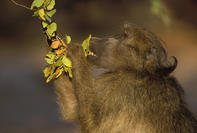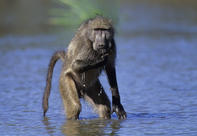Baboon Diet

Baboons are omnivores meaning they eat both plant and animal materials. Most of their diet comprises fruit, seeds, bulbs, rhizomes, the thick bases of grass stems and invertebrates. They are extremely resourceful and will eat almost anything except rotting meat.
They even hunt. Baboons will capture small mammals and birds opportunistically including rabbits, birds like Egyptian geese and small antelope lambs. It is usually the more dominant males who will hunt and eat meat.
Baboons have dexterous hands with opposable thumbs. These are used to manipulate various food substances while foraging and feeding. This may take the form of peeling tough skin off fruit or overturning rocks in search of scorpions, insects or slugs. The fingers are nailed to assist with digging.
They will dig up clumps of grass which they shake free of loose dirt before eating or they may patiently dig to unearth a juicy bulb up to 30 cm below even hard ground.
On the inside of a baboon’s mouth there are cheek pouches with the capacity to hold as much food as their stomachs do. This is an insurance device that allows baboons to stuff their mouths full of food at resourceful sites. Should they need to evacuate the area due to danger, they can then chew and swallow the food at a later time while safely up a tree or elsewhere out of harm's way.
Mutualism

Baboons are known to associate with many other herbivores. Impala benefit from being around baboons as they respond mutually to the other’s alarm calls. Impala, as well as kudu, bushbuck and civet, pick up the scraps of fruits or shoots that baboons knock or drop out of trees.
Baboons are one of few animals with the dexterity to dig for water. In this regard they perform a useful ecological role, opening up pits in dry river beds and drainage lines that can subsequently be accessed by other animals like antelope especially during the dry times of the year. Another animal that does this is the elephant.
Baboons are very water dependent and need to drink daily. Baboons are undeterred by buffalo and elephants in an area. These large herbivores trample areas and open up feeding grounds for the smaller primates. Baboons also dig through elephant dung to extract tasty morsels of fruit or seeds that have passed undigested through the elephants gut.
By Megan Emmett